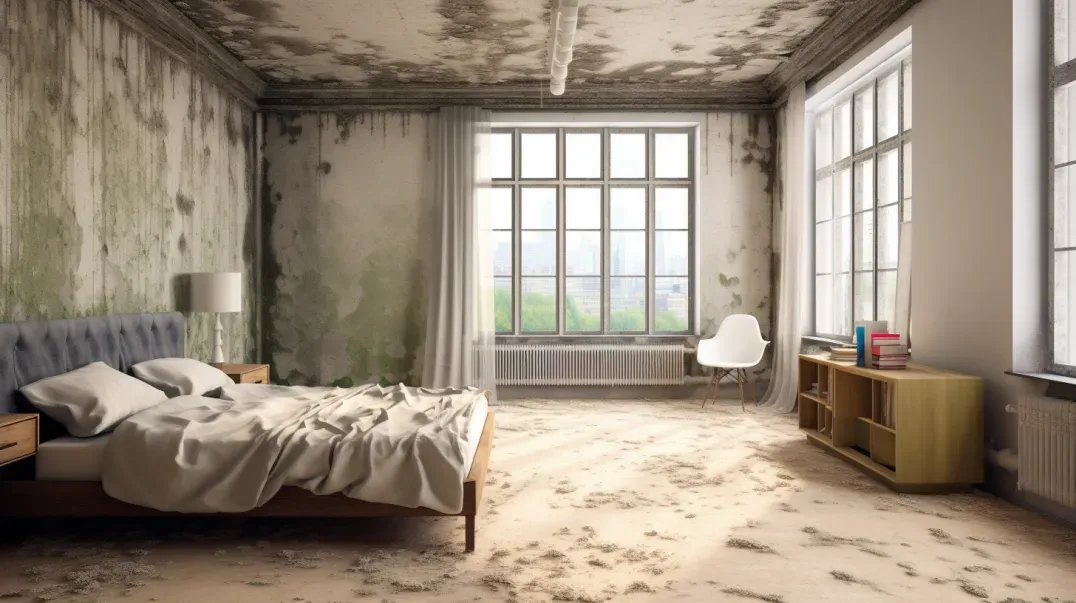The Role of Humidity Control in Mold Prevention
In the quest for a healthy and sustainable living environment, controlling indoor humidity emerges as a pivotal strategy against one of the most persistent challenges homeowners face: mold growth. Mold, a ubiquitous presence in both outdoor and indoor environments, thrives under certain conditions, with excessive moisture being its lifeline. The relationship between mold growth and humidity is not just a matter of comfort but a critical health and structural integrity concern. This blog delves into the intricate dance between humidity levels and mold proliferation, underscoring the importance of maintaining optimal indoor humidity as a fundamental preventive measure against mold.
Understanding the dynamics of humidity and its impact on mold growth is essential for creating a mold-resistant home. Mold spores, ever-present in the air, await the right combination of moisture and organic material to start their lifecycle. Once they find a hospitable environment, primarily one with high humidity levels, they can quickly grow and spread, leading to potential health risks and damage to home materials. However, by strategically managing indoor humidity, we can disrupt this cycle, keeping mold at bay and ensuring our homes remain healthy, safe, and comfortable.
This exploration into the critical role of humidity control in preventing mold growth will equip you with the knowledge and tools to effectively manage indoor moisture levels. From understanding the science behind mold and humidity to implementing practical strategies for maintaining an optimal indoor climate, we'll cover the essentials of creating a mold-resistant living space. Join us as we navigate the complexities of humidity control, offering insights, tips, and solutions that empower you to protect your home and health from the unseen threat of mold.
Understanding Mold and Humidity
The relationship between mold growth and indoor humidity is a critical aspect of maintaining a healthy living environment. Mold, a type of fungus that plays a vital role in nature by decomposing dead organic matter, can become a problem when it starts growing indoors. Understanding the basic biology of mold and how humidity affects its proliferation is essential for preventing its presence in our homes.
The Science of Mold Growth
Basic Biology of Mold and Conditions It Thrives In: Mold reproduces through tiny spores that float through the air, both indoors and outdoors. For mold spores to grow into mold, they require moisture, a food source (such as wood, paper, or fabric), and suitable temperatures. Mold can grow on almost any surface when moisture is present, making humidity control a key factor in mold prevention.
How Humidity Contributes to Mold Proliferation: Humidity levels play a significant role in mold growth. High humidity provides the moisture that mold spores need to germinate and grow. When indoor humidity levels are consistently above 60%, the risk of mold growth increases significantly. Reducing indoor humidity levels can deprive mold spores of the moisture they need, effectively inhibiting their ability to grow and spread.
Ideal Humidity Levels for Mold Prevention
Recommended Indoor Humidity Levels to Inhibit Mold Growth: To prevent mold growth, it is recommended to keep indoor humidity levels between 30% and 50%. This range is low enough to inhibit mold growth but high enough to be comfortable for occupants. Maintaining humidity within this range can help protect your home from mold damage and improve indoor air quality.
Tools for Measuring Indoor Humidity: Monitoring indoor humidity levels is crucial for mold prevention. Tools such as hygrometers, which measure the moisture content in the air, can help homeowners keep track of humidity levels. Many modern thermostats and HVAC systems also include built-in humidity sensors, providing real-time readings and the ability to adjust indoor humidity levels automatically.
By understanding the science of mold growth and the critical role of humidity, homeowners can take proactive steps to prevent mold in their homes. Implementing strategies to maintain ideal indoor humidity levels, such as using dehumidifiers, ensuring proper ventilation, and fixing leaks promptly, can significantly reduce the risk of mold proliferation, creating a healthier and more comfortable living environment.
Methods of Humidity Control
Controlling indoor humidity is essential for maintaining a comfortable, healthy living environment and preventing mold growth. Various strategies can be employed to manage moisture levels effectively, from enhancing ventilation to using dehumidifiers and moisture absorbers. Here’s a comprehensive look at these methods and how they can be implemented in your home.
Ventilation Strategies
Importance of Proper Ventilation in Moisture Control: Proper ventilation is crucial for controlling indoor humidity levels. It allows for the exchange of indoor air with outdoor air, helping to remove excess moisture and prevent condensation, which can lead to mold growth.
Tips for Natural and Mechanical Ventilation Methods:
- Natural Ventilation: Open windows and doors when weather conditions allow, to promote cross-ventilation and reduce indoor humidity. This is most effective in dry climates and during parts of the day with lower outdoor humidity.
- Mechanical Ventilation: Use exhaust fans in high-moisture areas like bathrooms and kitchens to expel moist air directly outside. Consider installing a whole-house ventilation system for continuous air exchange, especially in tightly sealed homes.
Dehumidifiers and Air Conditioners
How Dehumidifiers Work to Reduce Indoor Humidity: Dehumidifiers remove moisture from the air by drawing in humid air, cooling it to condense the moisture, and then reheating the dry air before releasing it back into the room. They are particularly useful in basements and other areas prone to dampness.
Using Air Conditioning Effectively for Humidity Control:
- Air conditioners not only cool the air but also remove moisture through condensation. To use an air conditioner for humidity control:
- Set your air conditioner to a “dry” or “dehumidify” mode, if available, to focus on removing moisture while using less energy.
- Ensure your air conditioning system is correctly sized for your space. An oversized unit may cool the room quickly without effectively removing humidity.
Moisture Absorbers and Desiccants
Natural and Commercial Options for Absorbing Excess Moisture:
- Natural Absorbers: Items like rock salt, charcoal briquettes, and baking soda can absorb moisture in small areas. These are eco-friendly options suitable for closets, drawers, and small spaces.
- Commercial Desiccants: Silica gel and calcium chloride-based products are highly effective at absorbing moisture in larger areas, such as basements and garages.
Best Practices for Use and Placement:
- Place moisture absorbers in areas with limited airflow where moisture tends to accumulate.
- Regularly check and replace or recharge absorbers as per the manufacturer’s instructions to ensure they remain effective.
- Keep commercial desiccants out of reach of children and pets, as some can be harmful if ingested.
By employing these humidity control methods, you can significantly reduce the risk of mold growth and create a more comfortable living environment. Whether through improved ventilation, the use of dehumidifiers and air conditioners, or the strategic placement of moisture absorbers, managing indoor humidity is a key aspect of maintaining a healthy home.
Humidity Control in Different Areas of the Home
Humidity control is a critical aspect of maintaining a healthy and comfortable home environment. Different areas of the home face unique challenges when it comes to managing moisture levels. By understanding these challenges and implementing effective solutions, homeowners can prevent mold growth, protect structural integrity, and ensure a comfortable living space. Here’s how to manage humidity in bathrooms, kitchens, and basements or crawl spaces.
Managing Humidity in Bathrooms
Specific Challenges and Solutions for Bathroom Humidity: Bathrooms are high-humidity areas due to showers, baths, and sinks. Without proper ventilation, this moisture can lead to mold growth and damage to walls and fixtures.
Importance of Exhaust Fans and Window Use:
- Exhaust Fans: Installing and using an exhaust fan that vents to the outside is crucial for removing moist air from the bathroom during and after showers or baths. Ensure the fan is appropriately sized for the bathroom’s volume.
- Window Use: Opening a window, if available, can help increase ventilation and reduce humidity levels. However, this is weather-dependent and may not always be practical.
Kitchen Humidity Management
Cooking and Dishwashing as Sources of Humidity: Cooking, especially boiling and simmering, and the use of dishwashers release significant amounts of moisture into the air. This can contribute to elevated humidity levels in the kitchen.
Effective Ventilation and Moisture Control Techniques:
- Range Hoods: Use a range hood that vents outdoors when cooking to capture steam and hot air. Ensure it is turned on before you start cooking and leave it running for a few minutes after finishing.
- Moisture-Resistant Materials: Consider using moisture-resistant materials for kitchen cabinets and walls to prevent moisture absorption and mold growth.
- Air Circulation: Keep the kitchen well-ventilated by opening windows or using an air conditioner or dehumidifier to help manage humidity levels.
Basements and Crawl Spaces
Challenges of Humidity Control in These Areas: Basements and crawl spaces are prone to dampness due to their below-ground location. Moisture can seep through foundations and lead to high humidity levels, making these areas susceptible to mold and mildew.
Strategies for Maintaining Dry Conditions:
- Dehumidifiers: A dehumidifier can be an effective tool for reducing moisture levels in basements and crawl spaces. Choose a unit sized appropriately for the area and empty the water collection reservoir regularly.
- Sealing and Waterproofing: Seal cracks in foundation walls and floors to prevent water seepage. Consider waterproofing the exterior foundation to further reduce moisture intrusion.
- Proper Drainage: Ensure that the home’s exterior drainage system directs water away from the foundation to prevent moisture accumulation in basements and crawl spaces.
By addressing the unique humidity challenges in bathrooms, kitchens, and basements or crawl spaces, homeowners can significantly improve indoor air quality and prevent the adverse effects of excessive moisture. Implementing targeted ventilation and moisture control strategies in these key areas will help maintain a healthy, comfortable, and mold-free home environment.
Integrating Humidity Control into Home Design
Creating a comfortable and healthy living environment requires more than just aesthetic design; it necessitates a strategic approach to humidity control. By incorporating moisture management into the initial design of a home, homeowners can prevent mold growth, structural damage, and indoor air quality issues. This section explores how building materials, design considerations, and external landscaping can play pivotal roles in regulating indoor humidity levels.
Building Materials and Design Considerations
Choosing Materials That Help Regulate Humidity: Selecting the right building materials is crucial for maintaining balanced indoor humidity levels. Materials such as vapor-permeable walls and floors can help manage moisture by allowing it to pass through the structure, rather than trapping it inside. Using mold-resistant drywall, especially in high-moisture areas like bathrooms and kitchens, can also prevent mold growth.
Design Features That Promote Effective Moisture Management: Incorporating design features that facilitate natural ventilation and moisture escape is key to preventing excessive humidity. This can include:
- Strategic Window Placement: Windows not only provide natural light but can also enhance cross-ventilation when placed opposite each other in a room.
- Ventilated Roof Design: A well-ventilated roof helps release hot, moist air that rises and accumulates at the top of a home.
- Moisture Barriers: Integrating moisture barriers in walls, floors, and roofs can prevent external moisture from penetrating the home, while allowing internal moisture to escape.
Landscaping and External Factors
How External Landscaping Can Impact Indoor Humidity: The landscaping around a home can significantly affect its indoor humidity levels. For instance, dense foliage close to the home can restrict airflow and trap moisture against the structure, while certain types of ground cover can increase the ambient moisture around the foundation.
Tips for Outdoor Modifications to Reduce Indoor Moisture:
- Proper Grading: Ensure the land around your home slopes away from the foundation to prevent water accumulation that can seep into basements or crawl spaces.
- Strategic Planting: Plant trees and shrubs at a distance from your home to allow for adequate ventilation and reduce the risk of moisture intrusion.
- Gutters and Downspouts: Install and maintain gutters and downspouts to direct rainwater away from the home, minimizing ground moisture near the foundation.
By thoughtfully integrating humidity control measures into home design, from the selection of building materials to landscaping decisions, homeowners can create spaces that are not only aesthetically pleasing but also healthy and durable. These proactive steps can safeguard the home against moisture-related issues, ensuring a comfortable living environment for years to come.
Monitoring and Adjusting Humidity Levels
Maintaining optimal humidity levels is crucial for creating a comfortable and healthy living environment. Excessive humidity can lead to mold growth and structural damage, while too little humidity can cause respiratory problems and discomfort. Understanding how to monitor and adjust humidity levels, as well as respond to seasonal changes, can help homeowners maintain a balanced indoor climate year-round.
Regular Monitoring for Effective Control
How to Regularly Check and Adjust Humidity Levels: The first step in effective humidity control is regular monitoring. Keeping an eye on indoor humidity levels allows homeowners to take action before any problems arise. Ideally, indoor humidity should be kept between 30% and 50% to prevent mold growth and ensure comfort.
Tools and Technology for Humidity Monitoring:
- Hygrometers: These devices measure the moisture content in the air. Digital hygrometers can provide accurate readings and are easy to use. Some models can be integrated into smart home systems, allowing for real-time monitoring from smartphones or other devices.
- Smart Thermostats: Many smart thermostats offer built-in humidity sensors and can automatically adjust the heating or cooling system to maintain desired humidity levels.
- HVAC Systems with Humidity Control: Advanced HVAC systems can regulate both temperature and humidity, providing a comprehensive solution for indoor climate control.
Responding to Seasonal Changes
Adjusting Humidity Control Strategies for Different Seasons: Humidity levels naturally fluctuate with the seasons, requiring adjustments to humidity control strategies throughout the year.
- Winter: Indoor air tends to be drier in the winter, especially in cold climates where heating systems are in constant use. Using a humidifier can help add moisture to the air, improving comfort and preventing dry skin and respiratory issues.
- Summer: High outdoor humidity levels in the summer can lead to excessive indoor humidity. Using air conditioners or dehumidifiers can help remove excess moisture from the air, preventing mold growth and maintaining comfort.
Understanding How Weather and Climate Affect Indoor Humidity: Weather patterns and the local climate have a significant impact on indoor humidity levels. In areas with high rainfall or in coastal regions, maintaining lower indoor humidity levels may require more aggressive use of dehumidifiers and ventilation. Conversely, in arid climates, the use of humidifiers may be necessary to prevent the air from becoming too dry.
FAQs
Contact Lowcountry Crawlspaces Today!
Lowcountry Crawlspaces will do everything we can to ensure your experience with us is excellent.
Request A FREE Estimate
CHECKOUT RECENT POST



Schedule Your FREE Crawl Space Evaluation Today
There Is No Crawl Space Job We Can’t Fix!




